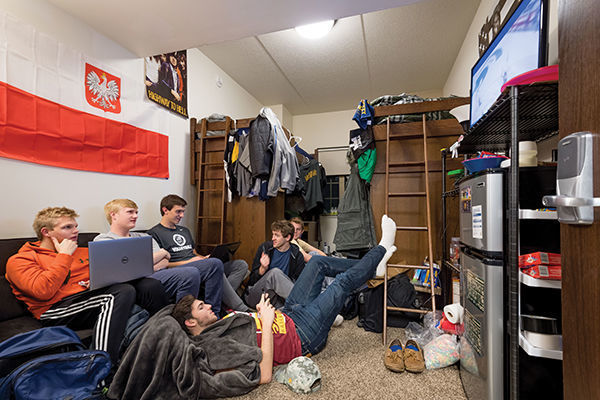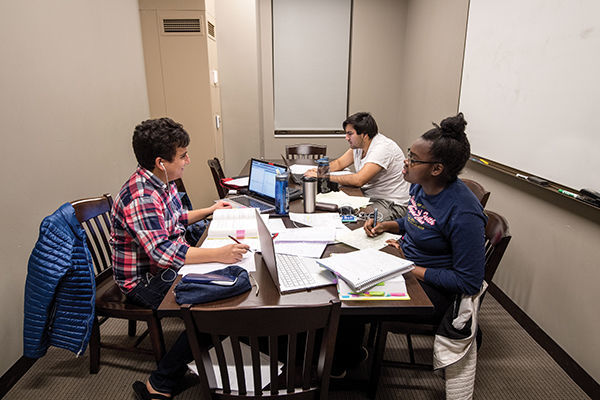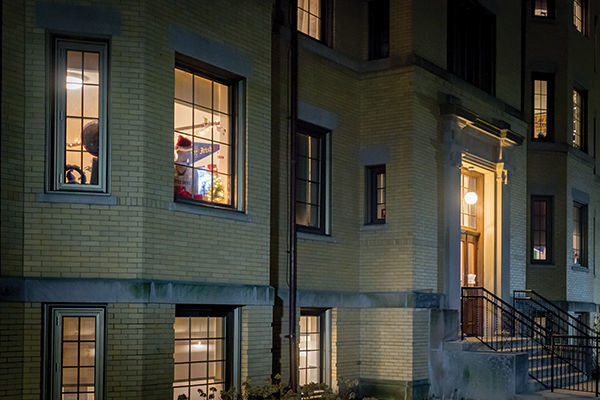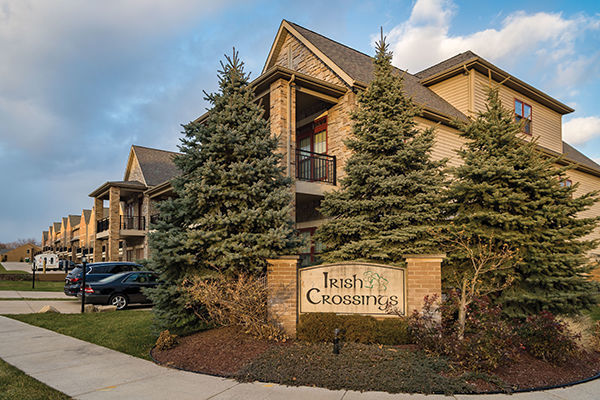 Photos by Matt Cashore ’94
Photos by Matt Cashore ’94
As I report on residence life at Notre Dame, through a cloud of nostalgia I see my fellow Shamrocks — some today preparing for their weddings — singing along to a bathroom radio while we all get ready on a Friday night.
As I interview rectors, I see my own rector, Sister Mary Lynch, SSJ, coming to the annual tea we host for her in our quad — the tea brewed in an illicit hot pot.
I see the McGlinn late-night crew wandering out to the section lounge to sip hot cocoa and study as our roommates sleep; interhall lacrosse games where we convince inexperienced friends to stand on the field holding a stick so we don’t have to forfeit; Masses we attend in slippered feet, in which the homilies relate the Gospels to the lives of 20-year-old women.
Notre Dame may have educated me, but McGlinn Hall formed me.
Today campus is quiet as I make my way to Main Building to chat with administrators about the University’s new six-semester, on-campus living requirement for undergraduates — the “strategies to strengthen undergraduate residential communities” as they’re titled in a news release. It’s fall break and the students have fled, leaving campus in a state of eerie autumnal abandonment.
The unusual tranquility underscores the topic at hand: the importance of the thousands of students who live, study, sleep, eat, succeed, fail, party and pray within the walls of each of Notre Dame’s 30 (soon to be 32) residence halls — the people and activity that shape the University’s tone and mission. Yet in recent years, more than 60 percent of seniors have elected to live off campus. A trickle of juniors (just under 15 percent) and sophomores (around two percent) have done the same, creating a challenge to the vision of a cohesive, residential learning community that the Student Affairs website calls “perhaps the most distinctive feature of the undergraduate experience at Notre Dame.”
To address that trend and emphasize the importance of Notre Dame’s “residentiality,” the administration announced in September that all students, beginning with the class of 2022, will be required to live on campus for six semesters instead of the current two, with study abroad counting toward that quota. In addition, officials are considering a range of new incentives to encourage seniors to stay in the halls beyond the baseline requirement.
The rationale for the changes is multi-pronged. Erin Hoffmann Harding ’97, vice president for student affairs, points to strategic planning led by University President Rev. John I. Jenkins, CSC, ’76, ’78M.A., and the executive officers, which named residential life as an area the University should highlight and fortify. Engagement from the President’s Leadership Council, deans and trustees then set the wheels in motion. Additionally, Hoffmann Harding says, the opening of Flaherty and Dunne halls in 2016 alleviated the overcrowding which had long constricted campus, while the construction of a new male dorm and a new female dorm, scheduled to open in 2019 and 2020, respectively, will further expand on-campus capacity. The additional space may also allow the University to guarantee housing for transfer students — and could mitigate a student frustration with pressure from local realtors to sign senior housing contracts as sophomores or even freshmen.
The September 13 announcement caused a campus buzz, even though no current undergraduate student will feel the impact of the change. At a town hall meeting Jenkins and Hoffmann Harding hosted that evening to discuss the issue, students raised concerns about economic inequality, racism and sexual assault, asking what recourse future students would have should they not feel safe or welcome in the communities where they will soon be required to live. Others wondered whether the communities of shared experience, friendship, support and mentorship that the University hopes to create in the halls will feel as genuine if students are obligated to remain on campus.
The initial response amplified a long-running conversation about the value of residentiality itself and its significance to the educational, social and spiritual environment at Notre Dame.
In a 1979 doctoral dissertation titled “The Notre Dame Ethos: Student Life in a Catholic Residential University,” former residence hall rector Rev. David E. Schlaver, CSC, ’64, ’69M.A., called residentiality “the underlying force, the linkage to the entire ethos of modern Notre Dame.

“There are many other factors that contribute much,” he wrote, “but without this continuous commitment to residentiality and without a vision of what it can mean in years to come, the other hallmarks — the Catholic character and academic excellence — would perhaps recede into mediocrity as seems to have happened on so many other campuses.”
The residence halls today remain distinguishing trademarks of the Notre Dame experience. About 80 percent of the student body lives on campus. Within days of orientation, students are convinced that their randomly assigned hall is the best one of all. Students typically stay in the same hall until they move off campus or graduate — the “stay-hall system” — creating an identity that for many alumni remains forever primary.

Years later, our halls still shape how we as alumni greet one another. We rarely ask what our fellow alums studied — preferring to know which hall they lived in, which community shaped them.
Yet what seems obvious to current students and alumni as a defining element of our Notre Dame education is virtually unknown to prospective students. Few applicants choose Notre Dame because of the residence halls, notes Margaret Morgan '06, '08M.Ed., '11M.Div., director of residence life. Most learn about the hall communities only after they're admitted. Morgan says the new policy attempts to remedy that.
“Our university is saying, ‘Your residential experience is foundational to your time here,’” she says. “And that’s a strong statement.”
Morgan recently spearheaded a project that explored questions of residential life, hosted focus groups of students and staff and benchmarked Notre Dame practices against those of peer institutions. The study found that Brown, Duke, Georgetown and others require students to spend six semesters in campus housing. Vanderbilt has an eight-semester requirement. Boston College boasts optional but highly coveted seniors-only residences.
Yet the quality of Notre Dame’s residential culture remains distinctive. Morgan’s study indicated it could become an attraction for prospective students if the University better conveys the value of these communities.
“One of the reasons we wanted to make this announcement so early was so all incoming students, before they applied, would have this information,” she says of the policy’s September unveiling.
At the town hall meeting, some students noted the six-semester requirement might indeed influence who applies to Notre Dame — by discouraging those prospective students who don’t like the idea.
Jenkins’ response was plain: That’s fine. “We want to be a place that prizes community in a special way,” he explained. “We make no apologies about that. . . . It would be a mistake to say we’ve got to make everybody happy.”
Life in the hall
Notre Dame’s residence life system is unparalleled. Considering the stay-hall system, the universal single-sex organization of the halls, the academic and spiritual programming and some aspects of Greek life — minus the pledging and exclusion — it has an identity of its own.
From the moment on Welcome Weekend when freshmen pull up to their dorms, they are claimed as members of their hall communities. Within hours, enthusiastic sophomores decked in dorm gear are teaching these freshmen the hall’s traditions and a silly song and dance to perform throughout orientation. It’s trivial, yes, but it shakes away the nerves and allows the first seeds of community to be planted.
“The Notre Dame community is unique in that it gives you a sense of pride and belonging which is inclusive right from the beginning,” says junior Joseph Trzaska, the president of St. Edward’s Hall. Throughout the year, interhall sports, section contests and hall activities reinforce the spirit of each community.
Because housing assignments are random, the communities formed are diverse in socioeconomic backgrounds, hometowns, religions, personal interests and majors. Students quickly learn to live and communicate with people very different from themselves. Neighbors can educate and shape one another through routine events such as dinners at the dining hall, decorating for the holidays and conversations while brushing teeth — or by having a contraband coffee maker that the whole floor uses on snowy mornings. Community bonds are further strengthened when someone is sick or grieves sad news from home.
Students are spiritually shaped in the halls as well. Dorm Masses are tailored to address the issues and questions of 18- to 22-year-olds. I felt it was the first time the Gospels were approachable or applicable, which inspired deeper understanding and adoration. The hall chapel was also where we rallied to support and pray for one another, or to gather en route to the Grotto. The quiet trust of our faith community grew because we celebrated Mass together in our home.
The presence of an in-residence priest also taught us about living in community. We joked we could set our watches by Father Tom Blantz, CSC, ’57, ’63M.A., and his walks from McGlinn to Corby Hall, but his routine, despite snow or sleet, was a constant reminder of how we’re meant to live with and serve one another. Father Tom continues to be a friend and model of Christian life, even years after my graduation.
The halls play a role in academics as well. John McGreevy ’86, dean of the College of Arts & Letters, says students who live on campus are more likely to engage with its academic life.
“We know education and learning often occurs outside the classroom,” he says, “and it doesn’t occur on a 9-to-5 schedule.”
Academic programming in the halls includes some in-residence faculty, courses in hall lounges, academic mentoring around class selections and an occasional invite-your-professor dinner. Even more formative is the informal curriculum. In my time at Notre Dame, my roommates included two engineers who often discussed concrete in our common room; a scientist who shared stories from her mosquito lab; a theology and art student who hung her paintings on our walls; and a student who thought about nothing but Dante for a year. By being randomly placed in a quad as a freshman, my academic curiosity widened.
Looking at how all these components contribute to hall life, Heather Rakoczy Russell ’93, associate vice president for residential life, says, “All those things together somehow help people figure out their place in the community, their place at the University, and ultimately to form them as human beings who are looking for the ways they hope to serve in the world.” More time together in that environment, she believes, leads to stronger formation.
The rector of Keough Hall, Rev. Patrick Reidy, CSC, ’08, ’13M.Div., says encouraging personal formation in community reflects Father Moreau’s vision that the Congregation of Holy Cross and its academic institutions might emulate the Holy Family.
“This place has formed its students into a way of being that allows the rector, the RA, the assistant rector to be something of a mentor, a confidant, a friend, in a way a sibling or a parent would be in a family,” he says. Upperclassmen may become big brothers and sisters who can advise and set an example for younger students.
Reidy notes that the need for family may be greater now because the student body is so high-achieving. Many, he says, have never failed before coming to Notre Dame. Here, they might: They might fail a test, experience their first heartbreak, get too drunk. In those moments where things are broken, he says, the support of a community is essential.
Keeping seniors on campus
The ideals of support and mentorship animate the other part of this new residential strategy: a set of incentives to motivate seniors to stay on campus. Options include flexible dining plans, adjustments to the senior room-pick process and additional leadership opportunities in the halls. Incoming classes will have the opportunity to shape their own incentives.
The goal is that the senior class should enrich the community by sharing life experience and serving as role models for younger students. The new incentives, says Hoffmann Harding, acknowledge the value of their presence.
Some students worry the changes may backfire and cause more seniors to flee campus.
“If I knew coming in I would be required to live in St. Ed’s for three years, I would not have the same perception of the dorm as I have now, and I’d be more likely to move off campus next year,” Trzaska says. “It would feel like you were trapped in an artificial community rather than enjoying this genuine community.”
Here lies a natural tension. Students are bristling at what feels to them like a mandate from an overprotective administration. But administrators and alumni know those years in the hall are precious. Experience has taught us that even if you remain connected to Notre Dame, coming back for football games, to work or to pursue a second degree, the residence-hall experience slips away quickly and doesn’t return.
I stayed in McGlinn my fourth year, but my decision didn’t stem from a sense of duty or community as administrators might hope. I simply felt the walk from the library to the hall was shorter than the walk off campus. I wonder whether the proposed incentives would have motivated me to stay more involved in hall life, rather than plunging deeper into my studies and shuttling back and forth to hang out with friends in a McGlinn apartment off campus. It’s possible.
But some seniors have expressed doubt that any incentives would motivate them to stay. While they appreciate their time in the halls, by senior year many are looking for a taste of the real world, fewer rules, better amenities. They want to feel they’re transitioning into adulthood.
Alyssa Lyon and Brandon Ryan are seniors and co-chairs of the Hall Presidents Council, which oversees nearly all student programming in the dorms. They argue that complaints particular to older halls, such as the lack of air conditioning and inconsistent room sizes — differences especially striking when compared to the newer halls for which students pay the same room and board — need to be addressed before implementing an on-campus requirement.
They also cite the perennial complaint of inconsistencies between male and female dorms as a reason seniors move off campus. Although female students perceive their hall rules to be stricter, data collected by the Office of Strategic Planning and Institutional Research shows women at Notre Dame are less likely to leave campus housing than men.
The data also complicates the criticism that the new policy will unfairly impede students from lower-income families who may look at off-campus rentals as an opportunity to save money. The numbers suggest these students are likelier to stay, even though Notre Dame allows financial aid packages to be used on and off campus.
In the 2017-18 academic year, average room and board costs $14,890 — about $2,750 over the average for national private, nonprofit universities, according to the College Board.
Off campus, at two of the most popular undergraduate apartment complexes, monthly rent on a 12-month lease will run $960 per person at Irish Crossings or $830 at Irish Row, plus electricity. Add in around $200 per month for groceries and other living expenses, not to mention a car or renters insurance, and Notre Dame’s cost looks competitive. Less expensive options exist, such as living farther from campus or splitting rent on a house among several friends, but the most popular options prove pricey.

As for the impact of this new policy on these apartments, Kristie Pinto, community manager at Irish Row Apartments, isn’t too worried. Though competition for undergraduate tenants will increase, the closing this spring of on-campus graduate student housing complexes means new opportunities for South Bend landlords to appeal to graduate students.
Lingering concerns
Some student complaints are not so easy to dismiss. Hanna Zook is one of the rare juniors who lives off campus. She spent two years in Farley before moving to a house with friends. At the town hall, Zook wondered about the impact of the policy on sexual assault victims who no longer feel safe living in a place where they experienced trauma. When we talked, Zook mentioned other groups who may feel alienated from residence hall culture, such as LGBTQ students and students of color. “They recognized a lot of real problems,” she said of the response at the town hall. “But they didn’t address how they were going to fix those issues.”
Rakoczy Russell admits Zook’s town-hall question surprised her. In the many focus groups and brainstorming sessions, she says, the question of sexual assault survivors never arose.
“We would never do anything intentionally to the detriment of our students,” she says. “If someone was experiencing the effects of sexual assault or discrimination . . . we would want to be able to have a conversation and find out, based on that person’s experience, what would be the best thing for him or her.”
She adds that there will be a waiver system to excuse select students from the new requirement, but it won’t be one-size-fits-all.
The future of residence life
Historically, the University has often rewritten its housing policy. Rules about who may live off campus, where they may reside, how dorm rooms are allotted have all fluctuated — often, it seems, in correlation with the availability of campus housing. At different points, going back to the construction of Sorin Hall in 1888, room assignments have factored in grades and room costs. The introduction of the stay-hall system in the 1960s was one change; coeducation yet another. In this light, the six-semester requirement may be just another chapter in the evolution of a residential campus — or it could profoundly reshape the future of residentiality.
Questions about the impact of the new policy will linger. How will it affect applications for the Class of 2022? Which incentives are most likely to maximize the number of seniors who stay? How will the tone, rules and programming in the halls evolve in this new environment?
The new policy will bring consequences — intended and unintended — just as the other changes have, and the markers of success may not be quantitative. Senior retention may be an indicator, but the true test of the new policy is whether the halls better foster communities of people who love, serve, educate and form one another as they mature into adulthood, and whether that formation remains a key takeaway from a Notre Dame education.
Tara Hunt McMullen, a former associate editor of this magazine, is a freelance writer in North Carolina.